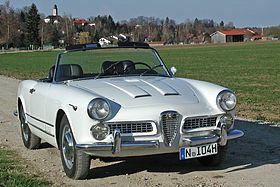Alfa Romeo 2000
| Alfa Romeo 2000 | |
|---|---|

Alfa Romeo 2000 Spider Touring
|
|
| Overview | |
| Manufacturer | Alfa Romeo |
| Production | 1958–1962 |
| Assembly | Portello, Milan, Italy (Berlina) |
| Designer | Sprint: Giorgetto Giugiaro (Bertone) Spider: Carlo Felice Bianchi Anderloni (Touring) |
| Body and chassis | |
| Body style |
|
| Layout | Front-engine, rear-wheel-drive |
| Related | Alfa Romeo 2600 |
| Powertrain | |
| Engine | 2.0 L I4 |
| Transmission | 5-speed manual |
| Dimensions | |
| Wheelbase | 2,700 mm (106.3 in) (Berlina) 2,500 mm (98.4 in) (Spider) |
| Length | 4,710 mm (185.4 in) 4,496 mm (177.0 in) |
| Width | 1,700 mm (66.9 in) 1,650 mm (65.0 in) |
| Height | 1,430 mm (56.3 in) 1,320 mm (52.0 in) |
| Kerb weight | 1,178–1,337 kg (2,597–2,948 lb) |
| Chronology | |
| Predecessor | Alfa Romeo 1900 |
| Successor | Alfa Romeo 2600 |
The Alfa Romeo 2000 (officially known as Tipo 102, Italian for Type 102) is a luxury car produced by Italian car manufacturer Alfa Romeo between 1958 and 1962, as a successor to the 1900 Super. It was replaced in 1962 by the Alfa Romeo 2600.
The 2000 was presented in 1957 at the Turin Motor Show, with 4-door, 6-seater saloon Berlina body. Production started in 1958, and the car was available as Berlina or Spider convertible. In 1960, the Sprint coupé was added. The 2000 Berlina had gearbox operated via column-mounted shifter making space for three people in front. The two grand touring versions had the gear lever located in floor, and a higher output engine. Until 1961, when 2+2-seater became available, the Spider was a pure two-seater. The last 2000s were built in 1962, when the improved six-cylinder Alfa Romeo 2600 was phased in.
The 2000 used unibody construction and a conventional front-engine, rear-wheel-drive layout. The engine was an enlarged version of the 1900´s inline-four displacing 1975 cc. The cast iron block and aluminium head engine produced 105 PS (77 kW; 104 hp) at 5300 rpm in Berlina using a single downdraft Solex carburettor, while the version on the Sprint and Spider produced 115 PS (85 kW; 113 hp) at 5700 rpm with two Solex sidedraft carburettors and a higher compression ratio. Two chain-driven overhead camshafts operated two poppet valves per cylinder. Power was sent to the rear wheels through a 5-speed gearbox, with synchromesh on all forward speeds.
...
Wikipedia
